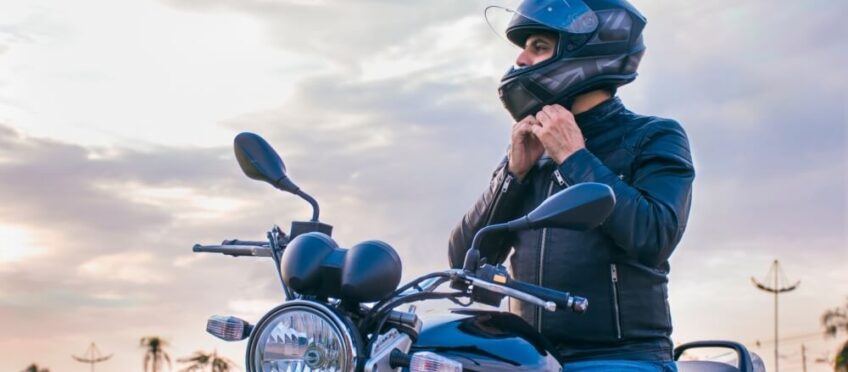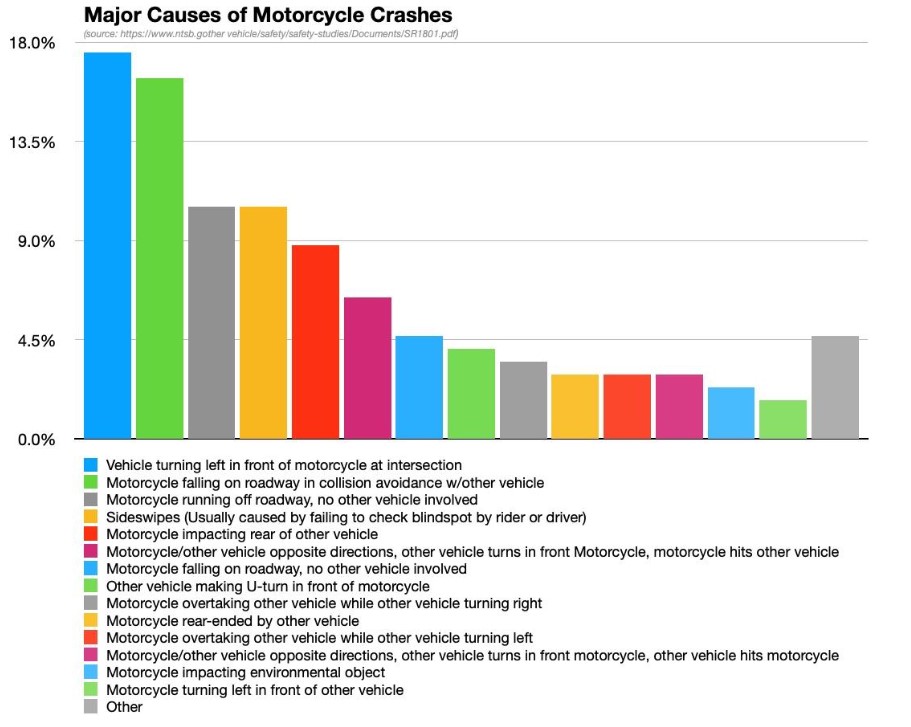If you’re looking for information about how to ride faster, lean your bike more, or get your knee down, you’ve come to the wrong place. This article is about being a safer sports bike rider on the street. We learn how by doing track days, taking courses, reading books, watching videos, and riding with more experienced riders. We learn how by making mistakes and learning from them. And we learn how by practicing. A lot! This article is a collection of titbits this Riders Plus Insurance writer has picked up along the way. While that means it’s not expert advice or meant to be definitive it is definitely something worth sharing.
Great sports bike riders take a safety-first approach, are committed to improving their riding skills, and are determined to develop second-to-none street awareness.
Although you ride (or want to ride) a sports bike, riding on the street is not like riding on the track. You face changing road conditions, debris, animals, and many other hazards. You have to account for this when you ride. Great riders have the discipline to ride safely, within their skill level, wearing the right gear.
Riding a high-performance sports bike takes advanced riding skills developed through hours of training and practice. Think of your favourite Moto GP rider – do you think they practice? Of course they do. A lot. If you want to be a great (and safer) rider, you need to commit to lifelong learning.
And of course, when you’re riding on the street, you face the unpredictability of other drivers, pedestrians, and road hazards. Understanding how traffic flows, what drivers and pedestrians typically do, and the hazards you might run into is called street awareness. Knowing a child will chase their ball onto the street is street awareness. Knowing the farmer will turn his tractor onto the highway is street awareness. Knowing the car driver can’t see you in their blind spot is street awareness. Developing second-to-none street awareness is critical to becoming a safe sports bike rider. Here are some of the most critical elements of rider safety that have been conveyed to this veteran rider:
Have a Safety-First Attitude
- Going fast and racing is for the track, not the street.
- Safety trumps everything. Oncoming vehicles, blind hills or corners, debris on the road, the potential for ATVs, horses, tractors, or Mennonite buggies, etc., all override choosing your ideal line or optimizing your speed.
- Reject peer pressure and ride your own ride. Peer pressure can be self-imposed; you want to keep up with your friends. But every rider’s skill is different. Stay on your own path. Trying to ride theirs can be catastrophic.
- Take responsibility for your own safety. I see motorcyclists put themselves in bad situations all the time. If something happens, debrief it honestly. “I was racing up the lane beside the line of cars. I should have been aware that at any time, one could stick its nose out to jump the queue. I should have proceeded at a slower speed with caution.” We know how car drivers drive: making left turns in front of us, following too close, and not seeing us, etc. Getting put in a dangerous situation, or crashing, because of something we know (or should have known) would happen, is our fault, regardless of what the law says. As riders, it is our responsibility to keep ourselves safe.
- Expect the unexpected; we know some corners will be tighter than we expect. (E.g., decreasing radius turns.) We know a parked vehicle or downed tree could be around the next blind corner or over the next blind hill. We know that debris might be in the middle of the next corner. If we crash because of something we know (or should have known), it’s our fault. As riders, it is our responsibility to keep ourselves safe.
- Always be able to stop within the distance you can see on your own side of the road.
- Stopping distance goes up exponentially with speed. For example, increasing our speed by 30 percent, e.g., from 50 km/h to 65 km/h, increases the stopping distance by 50 per cent, e.g., from 32 metres to 47 metres. Fifteen metres can make the difference between avoiding a collision or not!
- Don’t follow any vehicle you can’t see over.
- Don’t tailgate. (Or let yourself be tailgated. Pull over and let the vehicle pass if you have to.)
- All Moto GP riders wear ATGATT.
Be Committed to Improving Your Riding
- The best riders are the most skilled, the smoothest, and the fastest. They are also the safest riders.
- Wake up to your own incompetence. Thinking you’re a better rider than you are is the result of what is known as the better-than-average effect. It is the tendency for a motorcyclist to overestimate their riding ability relative to other riders. It states that, if asked, most riders will say their riding skills are better than average. But average means that some riders are below average, some are average, and some are above average. The majority of riders can’t be above average, it just isn’t statistically possible, yet when asked, that’s what most riders claim. Thinking you’re a better rider than you are is dangerous because you’re oblivious to your own shortcomings. What’s worse, when the time comes, you won’t have the skills to keep yourself out of harm’s way.
- Riding, without the practice and training it takes to handle any situation, is like being a pilot who can only fly on autopilot. As long as everything is okay, you’re fine, but if something sudden or potentially catastrophic happens, you won’t have the skills or calm under fire to handle it.
- If you want to learn racing skills, do a track day and get instruction from a certified racing school.
- Take an advanced riding course. I’ve taken courses with Police Motor Officers and many experienced sports bike riders. No one has ever felt they weren’t a better rider at the end of the day.
- Forget about getting your knee down. Greg Widmar of Motojitsu is a licensed instructor, author, and YouTuber. He asserts that knee-dragging isn’t needed on the street. Moving your upper body to the inside is all that is required. In fact, for all but the most extreme curves, a neutral body position is fine.
- When you go out to ride, set a daily goal. Today I am going to work on ___________ (fill in the blank). If you tighten up on the handlebars, practice noticing this and relax your grip every time you feel tense. Before you know it, you won’t be tensing on the handlebars, and you can work on something else. Choose only one skill to work on at a time.
- If you don’t like riding in the rain, go out and ride in the rain. (You will get caught in it eventually.) The upside is that you will learn how to do all of your inputs much smoother: clutch, throttle, and braking. This will carry over to your non-rainy-day riding. Great racers are smooth riders. (Not to mention, many riding courses and track days run rain or shine.)
- Complacency is the enemy of good riding. If you’re starting to feel too good about your riding, you’re in the danger zone. It’s time to shake things up by doing some solo practicing, reading a motorcycle book, or taking a course.
Read Keith Code’s A Twist of the Wrist II. He explains the seven panic reactions (he calls them survival reactions) that riders unwittingly do (because they are triggered by an automatic fight or flight response) when they get into a scary situation like going into a corner too fast. The thing is, all of them are opposite to the action you should take and can lead to a crash. Knowing them in advance will help you recognize them and override them with the correct action. Knowing what they are is the first step. (Keith Code is the founder of the California Superbike School.) - You improve by riding within your skill level. According to Code, once you pass the 75 per cent threshold (e.g., you’re riding within the top 25 per cent of your capability), you are prone to panic. Practice new skills under the 75 per cent threshold until you’ve mastered them. As you learn, your threshold will change.
- Being a better rider makes riding even more fun.
Improve Your Street Awareness Skills
- Know the major causes of motorcycle crashes. Knowing what they are allows you to be forearmed with riding strategies to deal with the most common high-risk situations. Note that the third highest cause is running off the road. Usually in curves, I suspect. Learn how to corner safely.
- Scan for obstacles (trucks, bus shelters with advertising, construction signs, etc.) that prevent other drivers or pedestrians from seeing you. Then put your bike where it can be seen.
- When debris is on the track, they red-flag the race until it’s cleaned up. On the street, you can encounter debris without warning. Anything from gravel in a corner to a two-by-four to a mattress that has blown off of the roof of a car. Expect it and always ride using the two-second rule.
- Assume every driver is distracted. Ride so that you have a bubble of safety and an escape route.
As riders, we want to have fun, but most importantly, we need to be safe. Taking a safety-first approach, improving our riding skills, and developing second-to-none street awareness will help make sure that we’ll always be able to ride another day.










join the conversation